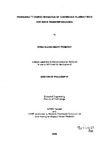Permeability characterisation of continuous filament mats for resin transfer moulding
| dc.contributor.author | Pomeroy, Ross Alexis Henry | |
| dc.contributor.other | Faculty of Science and Engineering | en_US |
| dc.date.accessioned | 2013-11-13T11:47:02Z | |
| dc.date.available | 2013-11-13T11:47:02Z | |
| dc.date.issued | 2009 | |
| dc.date.issued | 2009 | |
| dc.identifier | NOT AVAILABLE | en_US |
| dc.identifier.uri | http://hdl.handle.net/10026.1/2691 | |
| dc.description | Merged with duplicate record 10026.1/774 on 13.03.2017 by CS (TIS) | |
| dc.description.abstract |
This thesis seeks to examine both permeability measurement and material characterisation of Continuous Filament Mat (CFM) glass fibre reinforcements. As an alternative to fabrics, which generally provide higher in-place properties, CFMs are often employed as low cost, 'lofty' (high uncompressed thickness, and therefore good specific flexural stiffness), easy to process reinforcements for Resin Transfer Moulded (RTM) parts. Within this project, investigation of permeability measurement has involved the development of two (radial and linear) liquid flow permeability techniques to provide a reliable and robust data set for a specific CFM (Unifilo U813-300). Then two novel (radial and linear) airflow techniques were developed for the measurement of CFMs, these providing comparative results with the liquid flow measurements. The benefits of airflow versus liquid flow include cleaner, lower pressured flow using a fluid that may be produced by compressor rather than stored, therefore having significant benefits for both laboratory and industrial measurements of permeability. Material characterisation is necessary to analytically investigate reinforcement materials, as permeability has a non-linear relationship with overall porosity. Permeability is therefore considered as a function of pore distribution, which encompasses the two scales of intra and inter fibre-bundle flow. Two areas have been investigated, these involving permeability measurement and microstructure characterisation. Comparative permeability measurements of a second CFM (Unifilo U850-300), consisting of a different arrangement of fibre bundle sizes, were undertaken using the 1D airflow method, and inter-laminar flow was investigated using the radial airflow method. These resulted in a permeability ratio of between 0.54 and 0.64 (U813/U850) across a 0.1 to 0.3 fibre volume fraction range for the two CFMs, and no significant inter-laminar pore space effect. Microstructural characterisation initiated with image analysis of electron micrographs, providing measurement of fibre diameters and intra-bundle porosity. Kozeny-Carman modelling then showed the permeability of intra-bundle areas to be insignificant resulting in a focus on inter-bundle flow. Although limited by assumptions made for various material parameters, semi-empirical models to provide inter-bundle porosity and fibre bundle geometries were developed. Relation with permeability was then achieved through calculating hydraulic radius and mean hydraulic radius and provision of a range of Kozeny constants (0.55 to 6.17) and coefficients to replace the Kozeny constant, which provide upper and lower bounds for the remaining factors of permeability. The overall future industrial benefits for material engineers rely on the addressing of these limitations for quantifying geometries, so as to provide clarity of the relationship between controllable material parameters and permeability. Towards this goal, suggestions of further work here investigate employing micro-CT imaging and the use of 3D modelling that have the potential to use real-world images rather than idealised geometrical models. | en_US |
| dc.language.iso | en | en_US |
| dc.publisher | University of Plymouth | en_US |
| dc.title | Permeability characterisation of continuous filament mats for resin transfer moulding | en_US |
| dc.type | Thesis | |
| plymouth.version | Full version | en_US |
| dc.identifier.doi | http://dx.doi.org/10.24382/4367 |
Files in this item
This item appears in the following Collection(s)
-
01 Research Theses Main Collection
Research Theses Main


